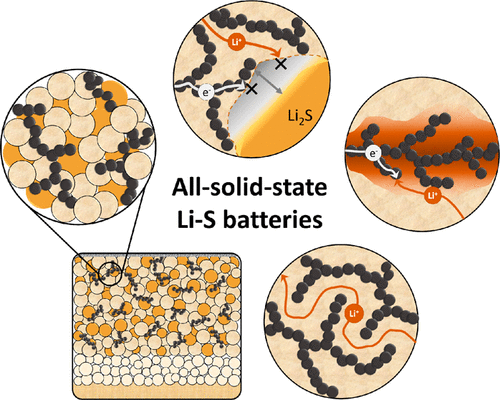当前位置:
X-MOL 学术
›
Acc. Mater. Res.
›
论文详情
Our official English website, www.x-mol.net, welcomes your feedback! (Note: you will need to create a separate account there.)
Toward Practical Solid-State Lithium–Sulfur Batteries: Challenges and Perspectives
Accounts of Materials Research ( IF 14.6 ) Pub Date : 2021-10-03 , DOI: 10.1021/accountsmr.1c00116 Saneyuki Ohno 1 , Wolfgang G. Zeier 2, 3
Accounts of Materials Research ( IF 14.6 ) Pub Date : 2021-10-03 , DOI: 10.1021/accountsmr.1c00116 Saneyuki Ohno 1 , Wolfgang G. Zeier 2, 3
Affiliation

|
The energy density of the ubiquitous lithium-ion batteries is rapidly approaching its theoretical limit. To go beyond, a promising strategy is the replacement of conventional intercalation-type materials with conversion-type materials possessing substantially higher capacities. Among the conversion-type cathode materials, sulfur constitutes a cost-effective and earth-abundant element with a high theoretical capacity that has a potential to be game-changing, especially within an emerging solid-state battery configuration. Employment of nonflammable solid electrolytes that improves battery safety and boosts the energy density, as lithium metal anodes are also viable. The long-standing inherent problem of conventional lithium–sulfur batteries, arising from the reaction intermediates dissolved in liquid electrolytes, can be eliminated with inorganic solid ion conductors. In particular, the highly conducting and easily processable lithium-thiophosphates have successfully enabled the lab-scale solid-state lithium–sulfur cells to achieve close-to-theoretical capacities. For applications requiring safe, energy-dense, lightweight batteries, solid-state lithium–sulfur batteries are an ideal choice that could surpass conventional lithium-ion batteries.
中文翻译:

走向实用的固态锂硫电池:挑战和前景
无处不在的锂离子电池的能量密度正在迅速接近其理论极限。更进一步,一个有前景的策略是用具有更高容量的转换型材料替代传统的嵌入型材料。在转换型正极材料中,硫是一种具有高理论容量的经济高效且地球储量丰富的元素,具有改变游戏规则的潜力,尤其是在新兴的固态电池配置中。使用不可燃固体电解质可提高电池安全性并提高能量密度,因为锂金属阳极也是可行的。传统锂硫电池长期存在的固有问题,由溶解在液体电解质中的反应中间体引起,可以用无机固体离子导体消除。特别是,高导电性和易于加工的硫代磷酸锂成功地使实验室规模的固态锂硫电池达到接近理论的容量。对于需要安全、能量密集、重量轻的电池的应用,固态锂硫电池是超越传统锂离子电池的理想选择。
更新日期:2021-10-22
中文翻译:

走向实用的固态锂硫电池:挑战和前景
无处不在的锂离子电池的能量密度正在迅速接近其理论极限。更进一步,一个有前景的策略是用具有更高容量的转换型材料替代传统的嵌入型材料。在转换型正极材料中,硫是一种具有高理论容量的经济高效且地球储量丰富的元素,具有改变游戏规则的潜力,尤其是在新兴的固态电池配置中。使用不可燃固体电解质可提高电池安全性并提高能量密度,因为锂金属阳极也是可行的。传统锂硫电池长期存在的固有问题,由溶解在液体电解质中的反应中间体引起,可以用无机固体离子导体消除。特别是,高导电性和易于加工的硫代磷酸锂成功地使实验室规模的固态锂硫电池达到接近理论的容量。对于需要安全、能量密集、重量轻的电池的应用,固态锂硫电池是超越传统锂离子电池的理想选择。



























 京公网安备 11010802027423号
京公网安备 11010802027423号